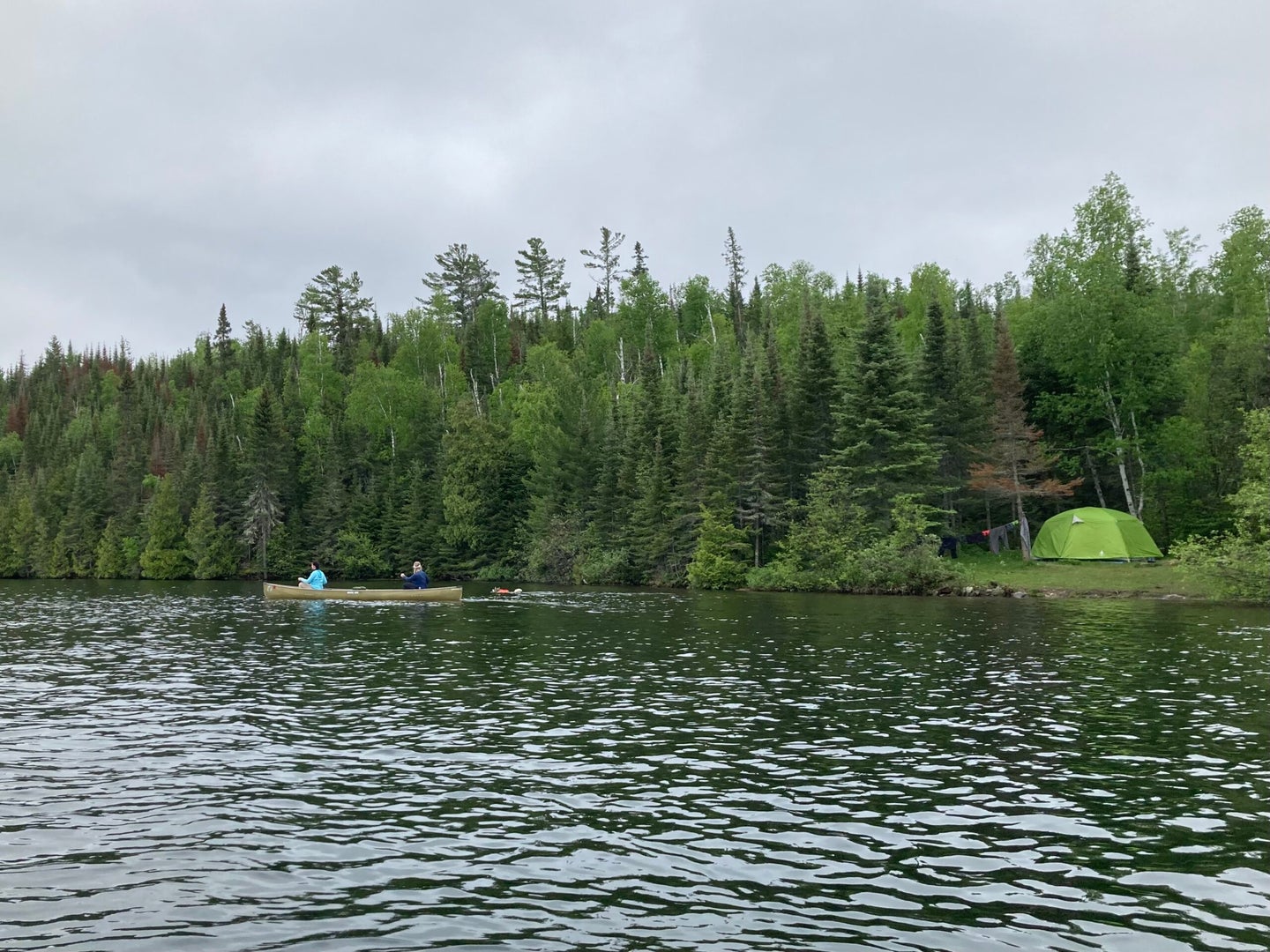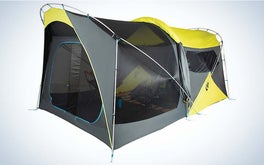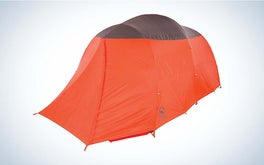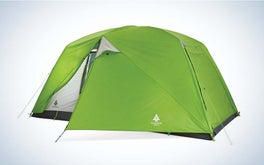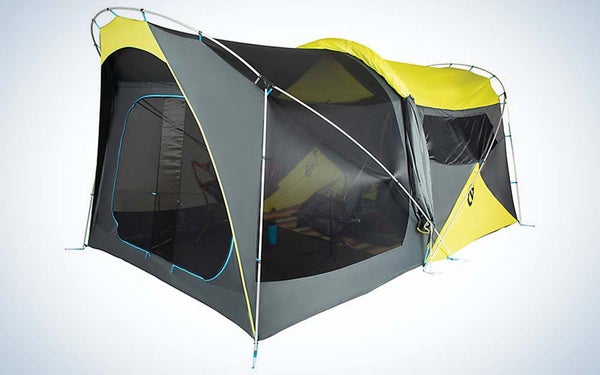We may earn revenue from the products available on this page and participate in affiliate programs. Learn more ›
Whether you want to get outside with your family or a group of friends, the best 8 person tents bring you closer together for a memorable camping experience. Using an 8 person tent while camping isn’t the best option for backpacking, but if you are car camping or canoe camping, a larger tent is feasible to transport. While many of these tents offer the space you need, what helped us narrow down our picks were the features, accessories, and field performance against the elements.
Even if you aren’t camping with a group of eight, having an 8 person tent is still great, even for groups as small as four. A tent of this size allows you to bring along pets, gear, and leaves room to spread out inside if the bugs or weather are too bad to enjoy more time outside the tent. Here are the best 8 person tents on the market.
- Best Overall: Nemo Wagontop 8 Person Camping Tent
- Easiest Setup: Big Agnes Bunk House 8
- Best with Multiple Rooms: Eureka Copper Canyon LX
- Best Weatherproof: H.U.B. High-Altitude Utility Base Camp Tent
- Best Value: Woods Lookout 8 Person 3 Season Tent
How We Made Our Picks
The best 8 person tents were chosen for review according to their overall value and quality. We narrowed down the products we felt served each category best and then conducted testing, company interviews, and evaluated verified customer testimonials from trusted sources. If a product could not be tested directly by the writer, information was gathered from someone with firsthand experience with the product.
Specific qualities we look for in 8 person tents include
- If there is enough standing room for multiple people within the tent.
- Can you set up the tent alone or with just two people?
- The projected lifespan of the product and materials
- Included accessories such as a footprint and its coverage area
- Company warranties or repair policies
Considering the size of the tent and vetting products from trusted companies means that our list only includes the most budget-friendly tent options. There is one tent that we’ve included to reflect the best value for the price. Tents from brands like Ozark Trail or Coleman did not make the cut. These are great beginner and budget tent brands; however, we did not feel their quality matched the products we chose to include below.
The Best 8 Person Tents: Reviews and Recommendations
Best Overall: Nemo Wagontop 8 Person Camping Tent
Key Features
- Materials: 75D PeU Polyester 1500 mm (canopy), 300D PeU Polyester 1500 mm (floor)
- Floor Area: 124.9 Square Feet
- Peak Height: 80 in.
- Packed Size: 28 x 13 x 13 in.
- Weight: 30 lbs
- Vestibules: 2
Pros
- Simple setup
- Large vestibule
- Durable design
- Spacious interior
Cons
- Weight
The NEMO Wagontop 8 Person Tent is a simple yet functionally designed tent that fits the car camping needs of most families and small groups. The vertical side walls and roomy vestibule make getting ready, packing, and hanging out comfortable, even for the tall guys in the group. Also acting as a screen room during warmer months, the vestibule adds space to an already roomy tent with a walk-in entry height of 80 inches. There is another backdoor vestibule, but it is much smaller. Having two doors is ideal with such a large group, though.
For the size of this tent, it is straightforward to set up. We still recommend having at least two people for the best results, and this tent goes up remarkably fast with a small group of people. The single-wall design of the tent helps with the efficient setup and is quite reliable in weather resistance. Be mindful of where you store gear and ensure nothing is touching the edges of the tents. Some customers remarked that where the vestibule cover meets the tent seam, it is prone to leaking. This may be due to the tent’s setup or a faulty seam. If you’re worried about the tent leaking at the seams, always check to ensure they are sealed.
Overall, this is a tent that is well worth the investment. If you are a frequent car camper with a group of friends or want to take the family out more on the weekends during the summer, the NEMO Wagontop 8 Person Tent is a reliable tent for 3-season camping.
Easiest Setup: Big Agnes Bunk House 8
Key Features
- Materials: Polyester
- Floor Area: 104 square feet
- Peak Height: 82 inches
- Packed Size:
- Weight: 22 lbs 15 oz
- Vestibules: 2
Pros
- Lifetime warranty
- Room separators
- Two large vestibules
- Fly and footprint can act as an open shelter
Cons
- Tent footprint sold separately
The Big Agnes Bunk House is available in various sizes, from four to eight people. The 8 person tent design is one of the easiest tents of this size to set up, which is why it made our list. It comes equipped with color-coded webbing and buckles, and guylines preattached to the fly. The hook and loop tabs that latch onto the poles are a breeze to clasp and quite effective in providing the necessary security, even on windy nights.
The simple yet versatile setup options allow campers to set up the tent in full or use it for events or as a sun shade for other occasions. To deploy the shelter mode setup, you only need a footprint (sold separately), the tent poles, and the rain fly. This is great for picnics, a beach day, or even a festival setup.
When the tent is fully deployed, you still get a nice open-air feel with an entire mesh ceiling. As a three-season tent that can fit up to eight people, good ventilation is a requirement. The tent is exceptionally functional in lousy weather, with a large vestibule on one side and another one big enough to be used with the door and to stash gear outside of the sleeping area.
Best with Multiple Rooms: Eureka Copper Canyon LX
Key Features
- Materials: 75-denier 190T polyester taffeta fabric
- Floor Area: 130 square feet
- Peak Height: 84 inches
- Packed Size: 11 in x 29 in
- Weight: 33 lbs 8 oz
- Vestibules: 2
Pros
- Near vertical walls for optimal standing room
- Integrated interior storage
- Adequate ventilation
- Excellent weather protection
- Easy two-person set up
Cons
- No fitted footprint available for this tent design
While several tents on our list provide the option to add separators to create different rooms within the tent, I liked the Eureka design because the vertical walls extend throughout the tent instead of sloping down like in other designs. The near-vertical wall design allows all campers to stand and move around the tent more freely. Many people assume that when buying a tent this large, you’re using it with your family. Well, many campers purchase a large tent for adult hangouts and weekends together. That means that several adults need to fit in the tent comfortably and may be more inclined to prefer privacy.
Beyond the size and design of the tent’s interior, the tent is an excellent value. The tent is durable and equipped with a sturdy steel and fiberglass frame. The setup is straightforward to follow and only requires two people. Next, the weather protection of the tent materials is ideal. When set up correctly, everyone will stay dry even in torrential rain and high winds. Our only real complaint with this tent is that it does not come with a footprint, and they do not sell one that can be attached to the tent. You can quickly remedy this by buying a footprint of a similar size for a different tent or purchasing a large tarp.
Best Weatherproof: H.U.B. High-Altitude Utility Base Camp Tent
Key Features
- Materials: 70D PU Nylon Taffeta (floor), 150D Ripstop Polyester (body)
- Floor Area: 108 Square Feet
- Peak Height: 79 inches
- Packed Size: 30 x 18 in
- Weight: 48 lbs
- Vestibules: 2
Pros
- Airline-friendly size and weight
- Flexible ventilation design
- Spacious interior
- Adequate gear storage space for 8 adults
- MSR repairs their gear
Cons
- No stakes, guylines, or set up instructions included
- Price
There is no beating the weather protection provided by a tent designed for professional alpinists and mountaineers. The MSR H.U.B. 8 Tent has housed hikers, climbers, expeditionists in their base camp, and even explorers and scientists in Antarctica. If you are heading out on an expedition or want a tent designed to tough out the harshest storms, this tent is hard to beat. Since it is intended for professional use, it does not come with stakes, guylines, or setup instructions. Tent stakes and guylines that fit your expedition needs can be purchased separately through MSR.
Regarding tent functionality, the high standing height provides enough headroom for most average adults to stand. There are interior gear pockets along with two large vestibules for gear storage. The optimized gear storage solutions within the tent design make it so eight adults and their gear can all fit inside this tent. As a four-season tent, ventilation is also a concern. There are plenty of window and door configurations to ensure that the tent is ventilated appropriately for the conditions.
Best Value: Woods Lookout 8 Person 3 Season Tent
Key Features
- Materials: Poly ripstop 210-tex 68-denier (body), Poly ripstop 210-tex 68-denier (floor)
- Floor Area: 112 square feet
- Peak Height: 78 inches
- Packed Size: 23.5 x 10 in
- Weight: 20 lbs
- Vestibules: 2
Pros
- Excellent quality for the price
- Easy set up with two people
- Relatively lightweight for the size
- Holds up well in heavy rain
Cons
- Could have better ventilation
Many of the 8 person tents on our list are over $500. If you are on a budget but don’t want to buy a cheaply built tent, the Woods Lookout 8 person tent is a great option. While it is just over $200, it still provides a high level of material and construction quality. The interior space is a simple yet effective design that provides standing room along with some interior gear storage.
The tent is relatively easy to set up if you have two people, and it goes up even faster with a group. The straightforward design makes this tent lighter than competitors and more portable for canoe camping. While you still would want to avoid carrying a tent of this size backpacking, if you are setting up a basecamp and need to haul gear for any distance, this is an excellent option since it only weighs around 20 lbs. Like most of the tents listed, this one does not come with a footprint, but one can be purchased separately.
Things to Consider Before Buying the Best 8 Person Tents
Intended Use
If you’re buying an 8 person tent, then it is best to consider how and when you plan to use it. If you have a family of four with a dog, an 8 person tent is a good size, but if you want it for a campout with eight adult friends, it might be too small.
The size of the tents will vary according to company and design, but when looking at tents, most people are most comfortable going up a size or two to give themselves more space while they sleep. So, if you have eight people in your group, we’d more likely recommend a ten-person tent to accommodate people and their gear. If you have a group of six, an 8 person tent should be just right.
Also, consider the number of pets you plan to bring. As an example, I was canoe camping in northern MN one summer with a group of four. While a smaller tent may have worked for us, I have two large-breed dogs. With an 8 person tent, we had just enough space for the four adults and the dogs. We could’ve made it work if we had more people, but we wouldn’t have been quite as comfortable.
The people and pets you are bringing with you play a massive role in the size of the tent you should get but also the design and durability. The best tents for families tend to have the highest level of durability. Kids, pets, and some adults put more wear on tents than others. Things like the tent floor or mesh can easily be damaged, so look at tents that are durable in construction and have a warranty or repair policy.
Your frequency of use should also be considered. If you’re a family that only camps one or two weekends a year, you probably don’t need to spend $1000+ on a tent. It may be more worthwhile to buy a lower-priced tent that provides a high level of value, like the Woods Lookout 8 Person 3 Season Tent we mentioned in our review.
Due to the size of most 8 person tents, they are better used for activities like car camping or canoe camping. The weight and size of the tent make it very difficult to use for backpacking, but some tents can be trekked to locations with the right group size, especially when using a basecamp location.
Materials and Durability
Look at the materials of each tent competent while shopping. These specifications should be listed clearly on a manufacturer’s website, and if you’re struggling to find this type of information about a product, move on to a different manufacturer. Transparency is a big part of customer service and the consumer experience, especially online shopping.
The durability of a tent, along with its functionality in terms of weather resistance, relies on the tent’s materials and construction. Camping tents are almost exclusively made from synthetic materials unless you shop for a canvas tent. Different tent parts are often made from other materials, and the overall fabric is usually a blend.
Common tent materials include:
- Cotton: used for canvas tents, cotton is heavy but durable tent material. When weathered appropriately, canvas tents are great for building a basecamp and insulate well in cold climates. Some canvas tents now utilize a polycotton material to improve durability and to create a lighter material.
- Polyester: potentially the most common tent material due to the low price, polyester is a petroleum-based fiber known for its durability and breathability. It does not shrink or sag with moisture build-up, which makes it an excellent option for all weather conditions.
- Nylon: lighter than polyester, nylon is another prevalent tent material. Many tents will blend polyester and nylon, or different parts of the tent may be made from one or the other. Nylon is a more expensive material than polyester but is also a bit more durable, making it a common choice for higher-end tent brands.
- Dyneema: one of the most durable tent materials is Dyneema. It is expensive to produce and is known for its use with climbing ropes, but it is now becoming more popular for some tent brands and other outdoor textiles. Most of the time, tents that utilize Dyneema use it with a blend of different materials to give the tent a boost in durability. The material is polyethylene with an ultra-high molecular weight, making it one of the strongest and lightest fabrics on the market.
Most camping tents come with water or weatherproofing of some kind. If you’ve ever noticed a plastic or chemical smell when sleeping in a new tent, it is from a PVC coating. PVC stands for polyvinyl chloride and is used as a fabric coating to make them waterproof. These coatings wear off over time and need to be reapplied. Some manufacturers are looking into and beginning to implement a water-based coating for textiles because PVC emits toxic fumes during production and after application.
Tent poles can also vary in material type. Common tent pole materials include steel, glass-reinforced plastic (GRP), aluminum alloy, and carbon fiber. GRP poles, also known as fiberglass poles, are very popular because they are less expensive to manufacture and are very flexible. They also tend to be less durable than other options like carbon fiber. Steel tent poles are very durable, but they’re used for square or frame tents instead of camping tents.
If you are in the market for a lightweight tent design, look for tent poles made from either aluminum alloy or carbon fiber. Carbon fiber is a strong and flexible material, but the only real downside to these poles is that they are more expensive. Aluminum alloy is comparable in flexibility to fiberglass poles but is lighter in weight, making them more popular for backpacking tents.
Tent components like mesh screens and footprints will utilize many of the same fabric materials as the main tent body. Another material to consider is that of the guylines and stakes. Since the footprint, guylines, and stakes can all easily be replaced if the ones that come standard with your tent are not of good quality, looking at the tent body material and poles should take priority.
Set-Up
There is a lot to consider when buying a large tent, and one of the first is how easy it is to set up. Beyond that, things like taking it down, packing it up, and transporting it become a concern. Since you’re likely traveling in a group, setting up shouldn’t be that difficult. The size and type of group will influence how much help you have while doing various camp chores.
Some eight-person tents can be set up alone, but most require at least two people to set it up effectively. If you attempt to set it up alone, read the instructions thoroughly and do not force the tent into positions that may damage the materials.
No matter the tent’s size, we always recommend that you set up a new tent before you use it outdoors. That way, you can determine if all the pieces are accounted for and if anything needs to be replaced or repaired, and it makes the setup time in camp a bit quicker because you’ve done it once before.
Weather Resistance
As with any tent, it is your shelter when you are camping. Whether you’re out there for a week or just one night, precipitation or high winds are always possible. This means it is always important to stay safe while camping. The top reviewed camping tents all across the board have one thing in common, no matter their size: they’re weather resistant. Some tents may have a higher level of weather resistance than others. For instance, a tent designed for expeditions and high altitudes will surpass one designed for summer ultralight backpacking trips.
Since an 8 person tent is much larger and taller than standard 2-3 person tents you’d bring backpacking, they may not be as resistant to wind. So, in those cases, look for a tent with good attachment points for guylines, stakes, and durability in constructing materials.
All tents should have their water resistance listed in the product specs or description. A coating is usually applied to the tent to give it a waterproof seal, and the seams should also be sealed or taped. Seams can easily be sealed if you have a tent that did not come that way.
If you bought a used tent or are unsatisfied with the water resistance that came stock with the tent, consider applying a waterproofing solution or spray to give the shelter a higher level of protection.
Interior Space
We can assume you are camping with a larger group if you want to purchase an 8 person tent. The amount of space needed for the group varies depending on the activity and individual needs of everyone involved. So, consider this when looking at group tents or buying a family tent.
Most 8 person tents are designed to allow for standing room for the average person (up to six feet generally) at least in the middle portion of the tent. Some tents have multiple rooms or separators that can be added to portion-off sections, allowing for more privacy. The interior space’s design and the tent’s features will vary depending on the concept and manufacturer. Knowing how much room you need is an excellent place to start, and then you can consider multiple rooms, standing space, gear storage, and vestibules.
FAQs
Q: What is the best material for an 8 person tent?
No matter the tent size, synthetic fabrics like nylon, polyester, or Dyneema are the best tent materials. These materials are easy to waterproof and tend to be very durable. A tent made from Dyneema is likely higher-end and higher-priced. However, the Dyneema tent’s weight-to-durability ratio is one of the best because of the ripstop stitching with mylar film.
Q: How many rooms would be enough for an 8 person tent?
An 8 person tent does not need to have separate rooms to be functional. Many 8 person tents are one large room, while others offer separators for more privacy. The number of rooms within the tent is up to the individuals using it and their level of comfort sharing a space. Usually, having two rooms is enough, but some campers may prefer three.
Q: Is it hard to set up an 8 person tent?
Sometimes it is hard to set up an 8 person tent, but the tents features on our list are all relatively easy to set up. No matter the ease of setup, with a tent of this size, it is almost always easier to set up with a group of people but, at a minimum, at least two people. The more hands you have to help with an 8 person tent, the easier to set up.
Q: Is it hard to warm up an 8 person tent?
Depending on the tent design, an 8 person tent can be harder to warm up than a smaller tent. The size of the room and the potential for many windows means heat can easily escape. You can choose to use tent-safe heaters within the tent if necessary or simply utilize a sleep system appropriate for the temperatures.
Q: What is the best type of tent for 8 people?
The best tent type for eight people is big enough for everyone to sleep comfortably and store their gear. If all of the campers are adults, choosing a tent that is rated larger (like a ten-person tent) may be a better option to provide additional space. For most parties, an 8 person tent comfortably sleeps six adults, but it can accommodate eight if you’re comfortable sleeping close together and utilize the vestibules for gear storage.
Q: How long will an 8 person tent last?
How long a tent lasts depends on the quality of the construction and materials, along with how well it is maintained. Frequency of use can also affect how long a tent lasts. Using an 8 person tent with a family or with pets may not last as long due to having a higher level of wear around animals and children. However, if you use the tent for adult campouts, it may last longer, depending on the group. Take care of the tent and keep it clean to help it last as long as possible.
The Best 8 Person Tents: Final Thoughts
- Best Overall: Nemo Wagontop 8 Person Camping Tent
- Easiest Setup: Big Agnes Bunk House 8
- Best with Multiple Rooms: Eureka Copper Canyon LX
- Best Weatherproof: H.U.B. High-Altitude Utility Base Camp Tent
- Best Value: Woods Lookout 8 Person 3 Season Tent
The best 8 person tent is the one that works best for your needs and your budget. While we may have included higher-priced options on our list, that doesn’t mean you can’t find a tent with the right value for the perfect price. Our top-rated tent is the Nemo Wagontop 8 Person Camping Tent due to the high quality of the construction and design. It is an easy tent to set up and offers ample space for groups and families. Even if you didn’t find the perfect tent on our list, we hope you can use the buying considerations to help you narrow down options as you shop.
Why Trust Us
For more than 125 years, Field & Stream has been providing readers with honest and authentic coverage of outdoor gear. Our writers and editors eat, sleep, and breathe the outdoors, and that passion comes through in our product reviews. You can count on F&S to keep you up to date on the best new gear. And when we write about a product—whether it’s a bass lure or a backpack—we cover the good and the bad, so you know exactly what to expect before you decide to make a purchase.
